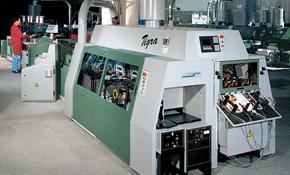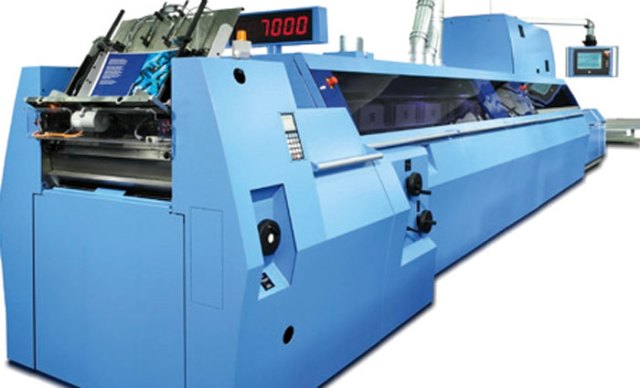Whether made by Heidelberg, Muller Martini, Kolbus or anyone else, gatherers that sit at the front end of the average perfect binder or saddlestitcher have followed broadly similar principles of design for section feed, transport and delivery for nigh-on 50 years – and in the context of latter-day industry conditions, those principles are beginning to creak. Literally. Heavier sections that come off 96pp and 104pp webs are prone to marking simply from the weight of their own pages and lighter stocks are prone to buckling, skewing and jamming. Faced with pressure to run faster, gatherers are straining to meet the demands placed on them.
So Muller Martini has spent the past five years quietly redesigning its top-of-the-range gatherer from the ground up. The objective, as well as providing a high-speed gatherer, has been to pave the way for a faster binder than Muller’s current top-of-the-range model, the Corona C18, which runs at 18,000 copies per hour (cph). In comparison, Muller’s perfect-binding rival Kolbus teamed up with newspaper specialist Ferag/WRH four years ago to produce the KM410.D Rollstream – a binder that happily achieves a top speed of 20,000cph.
Positive feedback
The result of Muller Martini’s labours, the new 3697, will be launched at Drupa. It is already being customer-tested here in the UK to resounding results, according to Muller technical systems manager John Gissing: “This is such a totally different machine, it’s going to shock a few people.” Gissing, then a bindery technician, saw the 3697 originally as a prototype in 2005, “and at the time I thought it was going to need a lot of work – I couldn’t see how it was an improvement over a normal design”. Four years later, the 3697 is a production model, and gamekeeper Gissing has turned poacher. He says: “The machine will be one of our show-stoppers, one that will really turn heads – it’s a step change in the way gathering is done.”
In the design of the new gatherer, Muller Martini has set out three main areas of change: ergonomics, flexibility of feeders and speed. All three areas are addressed by a combination of architectural and configuration changes to the gatherer’s componentry and overall design.
The feeders are the site of the most radical changes. Taking some tips from the roll-feeding concept that graces the Kolbus/Ferag machine, the new Muller feeder is a flatpile unit that puts the spine to the front and uses a suction rail to take the section out of the feeder pocket by peeling it away – “a bit like a section of orange peel,” says Gissing. The section is then gripped, maintaining its curvature. The sword, which is hollow, generates an envelope of air that keeps it curved. This is necessary to limit the movement of heavier ribbon-folded sections, says Gissing. “The section gets wrapped in a cushion of air. If you’ve got web-folded sections, there’s a weight issue that immediately becomes a marking issue.”
Easy transport
Literally floating on air, the section is transported into a set of rollers, onto a belt and straight onto the raceway. Which makes up the most immediately obvious change in the 3697’s design: there’s no bump turn because the gatherer doesn’t sit at right-angles to the binder, but instead is inline with it. The new design may challenge some factory floor layouts – particularly where it joins an existing line-up – but Gissing points out that longitudinal feed is gentler on the sections, because the raceway’s holding peg doesn’t need to act as a stop, “so you haven’t got the section smashing into the peg as on a normal gatherer”. He also says the longitudinal feed is a big factor in the speed increase: although it’s only rated at 18,000cph for now, the new gatherer can handle up to 25,000cph, he says. And, just in case there’s any need to hold heavier sections in place, there’s an option for ‘static nailing’, where a blast of static, invisibly but firmly, keeps the sections from sliding apart.
Because of the concave section principle, a single feeder design can now handle the majority of section types, including gatefolds, doing away with the need for different feeder designs such as back feeders, cross feeders et al. With the exception of the optional tip-on feeder, the main document feeders are of a single design. This uni-design also dramatically simplifies makeready and maintenance: Muller supplies a small cart and a spare feeder unit, so the gatherer can keep on running, while specific feeder units are swapped in and out for routine maintenance. The cart, and the easier, faster lift-off, represent a big advance on the old 3681’s swapout procedure, which called for a crane.
Along with its other virtues, the new feeder design is more accurate, due to the fact each unit is separately controlled using a servo drive. This makes it more accurate, as a feed – precision placement is set either centrally or on each feeder unit, and then tweaked to millimetre accuracy on the unit’s control panel. Gissing also says that makeready is faster using the new feeders, “because you’re not having to mechanically engage or disengage the drive to a central shaft”. And the hoppers can also be automatically fed.
The 3697’s concave raceway is a silver spine running the length of the machine. It maintains the sections in their gently curved shape, as they build up into a complete book block. The curved profile of the sections allows the gatherer to whiz them along much faster than otherwise, because the paper is inherently stronger when held in a curve.
“As an apprentice, one of the first things I learnt was how to break a paper stack,” Gissing says, “and you always bend a handful as you pick it up, to make it stiffer than when it’s flat.”
Other nice touches on the 3697 include CASAC, a new contact-free signature thickness measurement device, and an infra-red sensor that detects doubles and missing sections. The contact-free design has been introduced to eliminate the marking that can be generated by contacting callipers and it isn’t subject to temperature changes. In addition, the 3697 carries Muller’s standard Asir optical scanning system for detecting section error, both by image recognition and barcode.
The working height of the gatherer has also been adjusted, with an eye to easy loading, in particular. And, when linked to a Muller Martini binder, the gatherer can be set up from either the gatherer’s central control panel, or from its own central panel.
The pre-launch trials currently running in the UK are happening at a large magazine printer, which is where Gissing expects the majority of sales to end up, along with big trade finishers. Two chain pitches of 457mm and 609mm (the latter gives a reduced speed of 15,000cph) mean that the 3697 isn’t subject to much limitation in terms of the maximum section size it can handle. Gissing reveals that the machine is more limited by the section size that comes off the press.
The 3697 is intended for use with perfect binders only (and for the record, that’s not just Muller’s binders – this could equally well hook up to a Kolbus binder). There’s no opening mechanism in the feeder, so signatures can’t be sat on a saddle. Whether any of the 3697’s new features make it to an equivalent gatherer for a saddle-stitcher, Gissing doesn’t yet know. At any rate, it seems likely that Muller will focus its next design efforts on a horse for the 3697’s cart. As yet, there’s no Muller Martini (or anyone else’s) binder capable of taking book blocks at the 3697’s claimed top speed of 25,000cph.
Supplier: Muller Martini Australia
THE ALTERNATIVE
Kolbus KM410.D Rollstream
Unlike the Muller machine, this gatherer – attached to Kolbus’s KM410.D Rollstream binder that runs at a world-beating 20,000cph – doesn’t feed longitudinally, but remains at right-angles to the binder. The feeders themselves are rated at 40,000 sections per hour and can be fed by either roll or bundle feeders. One of the reasons for the speed may be the maximum book block size (a reduced chain pitch of 320mm limits its format capacity) and maximum book block thickness, which is a comparatively low 12mm (still plenty large enough, it must be noted, to handle most of the long-run magazine work in the UK). The sections are not curved, but held flat; there’s also an option for an inserter that can insert or onsert perfect bound books.
Max section size 240x320mm
Min section size 100x105mm
Max section thickness 4mm
Top speed 20,000 copies per hour (gatherer 40,000 copies per hour)
Price TBA
Comment below to have your say on this story.
If you have a news story or tip-off, get in touch at editorial@sprinter.com.au.
Sign up to the Sprinter newsletter


